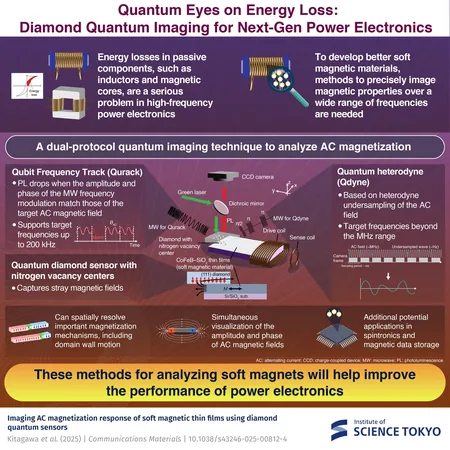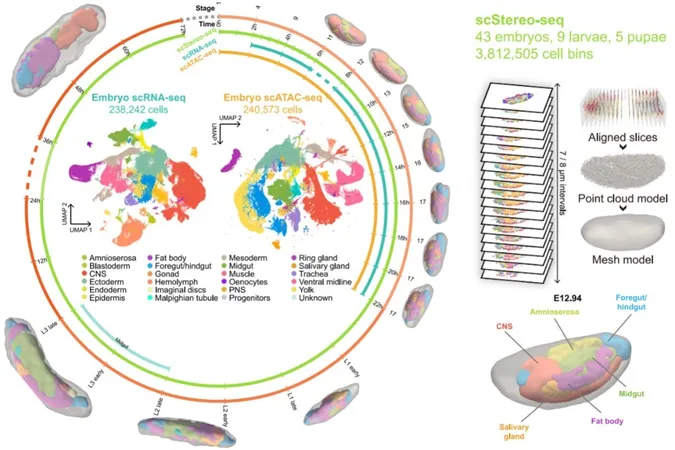
Unlocking Energy Efficiency: How Quantum Imaging with Diamonds is Revolutionizing Power Electronics
2025-05-23
Author: Sarah
The Quest for Energy Efficiency
In our drive towards a sustainable future, enhancing energy conversion efficiency in power electronics is more crucial than ever. Wide-bandgap semiconductors like GaN and SiC are at the forefront, providing incredible high-frequency capabilities. Yet, challenges remain as energy losses in passive components at elevated frequencies threaten to impede both efficiency and miniaturization. This highlights a pressing need for advanced soft magnetic materials that minimize energy losses.
A Groundbreaking Study in Quantum Imaging
A team led by Professor Mutsuko Hatano from the School of Engineering at the Institute of Science, Tokyo, has made significant strides in tackling this issue. In their groundbreaking study published in *Communications Materials*, they introduce a revolutionary technique for analyzing energy losses by capturing both amplitude and phase of alternating current (AC) stray fields, which are crucial for understanding hysteresis losses.
Diamond Quantum Sensors: The Future of Magnetic Field Imaging
Employing a cutting-edge diamond quantum sensor embedded with nitrogen-vacancy (NV) centers, the researchers devised two innovative protocols: 'qubit frequency tracking' (Qurack) for kHz frequencies and 'quantum heterodyne' (Qdyne) for MHz frequencies. This collaboration, which included partners from Harvard University and Hitachi, Ltd., realized a new frontier in AC magnetic field imaging.
Exciting Experimental Results
To test their method, the researchers conducted an impressive wide-frequency-range magnetic field imaging experiment. By applying an AC current to a 50-turn coil and sweeping frequencies from 100 Hz to 200 kHz with Qurack and 237 kHz to 2.34 MHz with Qdyne, they successfully mapped the uniform AC Ampere magnetic field's amplitude and phase with remarkable spatial resolution of 2-5 µm.
Revelations about Soft Magnetic Materials
Insightfully, the findings unveiled that CoFeB–SiO2 thin films, designed for high-frequency inductors, showcased minimal phase delay up to 2.3 MHz—indicating reduced energy losses along the hard axis. However, the energy loss escalated when the magnetization was directed along the easy axis, with phase delay increasing with frequency, which signifies heightened energy dissipation. This deepens our understanding of how magnetic anisotropy affects energy loss.
Paving the Way for Efficient Electronics
The implications of this research are monumental. Utilizing quantum sensing to understand soft magnetic materials at high frequencies addresses one of the most significant barriers to developing highly efficient electronic systems. The capability to observe domain wall motion—a key magnetization mechanism linked to energy losses—is critical for future advancements and optimizations in electronics.
Future Horizons: Enhancements on the Horizon
Looking ahead, Professor Hatano expresses a keen interest in refining these techniques. "The Qurack and Qdyne methods can be improved through engineering enhancements," he asserts. Potential upgrades include integrating high-performance signal generators to widen Qurack's amplitude range and optimizing spin coherence time alongside microwave control speed to expand Qdyne's frequency detection capabilities.


 Brasil (PT)
Brasil (PT)
 Canada (EN)
Canada (EN)
 Chile (ES)
Chile (ES)
 Česko (CS)
Česko (CS)
 대한민국 (KO)
대한민국 (KO)
 España (ES)
España (ES)
 France (FR)
France (FR)
 Hong Kong (EN)
Hong Kong (EN)
 Italia (IT)
Italia (IT)
 日本 (JA)
日本 (JA)
 Magyarország (HU)
Magyarország (HU)
 Norge (NO)
Norge (NO)
 Polska (PL)
Polska (PL)
 Schweiz (DE)
Schweiz (DE)
 Singapore (EN)
Singapore (EN)
 Sverige (SV)
Sverige (SV)
 Suomi (FI)
Suomi (FI)
 Türkiye (TR)
Türkiye (TR)
 الإمارات العربية المتحدة (AR)
الإمارات العربية المتحدة (AR)